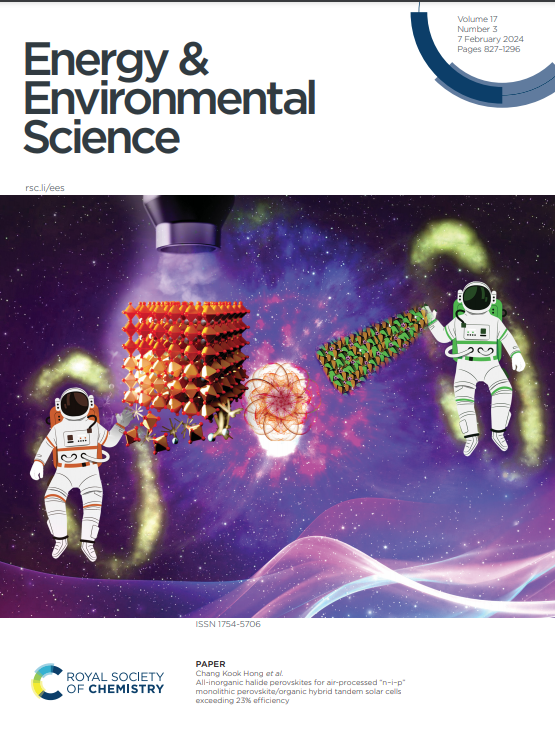Cross-linked nanoflower network and Se-doping enabling sulfur rich SPAN towards lithium‒sulfur batteries beyond 600 Wh kg‒1
IF 32.4
1区 材料科学
Q1 CHEMISTRY, MULTIDISCIPLINARY
引用次数: 0
Abstract
Sulfurized polyacrylonitrile (SPAN) is one of the most promising cathodes for high-energy-density lithium‒sulfur batteries since its distinctive organic skeleton and covalent sulfur storage mechanism effectively prevent polysulfide dissolution and mitigate volume expansion. However, its low sulfur content and sluggish reaction kinetics significantly limit the practical energy-density and commercial viability of Li‒SPAN batteries. Herein, we utilize hydrazine hydrate to synthesize a nitrogen-rich cross-linked nanoflower-shaped polyacrylonitrile (NH-FPAN) as the sulfur host material. During sulfurization, the abundant nitrogen adsorb sites and cross-linked network enable the coexistence of elemental sulfur and covalent sulfur, enriching the sulfur content from 40% to 65%. Moreover, the unique polymeric skeleton and selenium-doping accelerate reaction kinetics, leading to high utilization of sulfur capacity. Consequently, this cathode delivers an ultrahigh composite capacity over 1000 mAh g‒1 and exceptional stability over 6000 cycles. A coin cell with ultrahigh cathode loading of 24.8 mg cm‒2 affords remarkable areal capacity of 25.2 mAh cm‒2 and energy-density up to 638.6 Wh kg‒1. This strategy shows promise to break through the sulfur content and capacity limitation of SPAN, advancing Li‒SPAN batteries toward practical energy storage applications.交联纳米花网络和掺杂硒使富含硫的 SPAN 可用于 600 Wh kg-1 以上的锂硫电池
硫化聚丙烯腈(SPAN)由于其独特的有机骨架和共价硫储存机制,有效地防止了多硫化物的溶解和减缓了体积膨胀,是高能量密度锂硫电池最有前途的阴极之一。然而,它的低硫含量和缓慢的反应动力学极大地限制了Li-SPAN电池的实际能量密度和商业可行性。本文利用水合肼合成了一种富氮交联纳米花状聚丙烯腈(NH-FPAN)作为硫宿主材料。在硫化过程中,丰富的氮吸附位点和交联网络使单质硫和共价硫共存,使硫含量从40%富集到65%。此外,独特的聚合物骨架和硒的掺杂加速了反应动力学,导致硫容量的高利用率。因此,这种阴极提供了超过1000 mAh g-1的超高复合容量和超过6000次循环的卓越稳定性。具有24.8 mg cm-2的超高阴极负载的硬币电池具有25.2 mAh cm-2的显着面积容量和高达638.6 Wh kg-1的能量密度。这一策略有望突破SPAN的硫含量和容量限制,将Li-SPAN电池推向实际的储能应用。
本文章由计算机程序翻译,如有差异,请以英文原文为准。
求助全文
约1分钟内获得全文
求助全文
来源期刊

Energy & Environmental Science
化学-工程:化工
CiteScore
50.50
自引率
2.20%
发文量
349
审稿时长
2.2 months
期刊介绍:
Energy & Environmental Science, a peer-reviewed scientific journal, publishes original research and review articles covering interdisciplinary topics in the (bio)chemical and (bio)physical sciences, as well as chemical engineering disciplines. Published monthly by the Royal Society of Chemistry (RSC), a not-for-profit publisher, Energy & Environmental Science is recognized as a leading journal. It boasts an impressive impact factor of 8.500 as of 2009, ranking 8th among 140 journals in the category "Chemistry, Multidisciplinary," second among 71 journals in "Energy & Fuels," second among 128 journals in "Engineering, Chemical," and first among 181 scientific journals in "Environmental Sciences."
Energy & Environmental Science publishes various types of articles, including Research Papers (original scientific work), Review Articles, Perspectives, and Minireviews (feature review-type articles of broad interest), Communications (original scientific work of an urgent nature), Opinions (personal, often speculative viewpoints or hypotheses on current topics), and Analysis Articles (in-depth examination of energy-related issues).
 求助内容:
求助内容: 应助结果提醒方式:
应助结果提醒方式:


